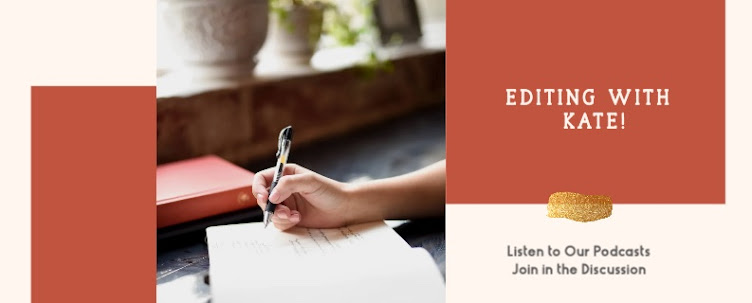 I’m Kate Devlin, a freelance editor and writer. I thought I’d tell
you a little about me and answer some questions about editing. I currently work full time for an IT recruiting company on our
communications and marketing team. My job involves writing for our company
blog, editing marketing materials, and reviewing and editing resumes before
they are submitted to clients. As a side hustle, I do freelance editing for a
variety of projects.
I’m Kate Devlin, a freelance editor and writer. I thought I’d tell
you a little about me and answer some questions about editing. I currently work full time for an IT recruiting company on our
communications and marketing team. My job involves writing for our company
blog, editing marketing materials, and reviewing and editing resumes before
they are submitted to clients. As a side hustle, I do freelance editing for a
variety of projects.
I’ve been using my editing skills for more than 20 years, and while not all my jobs have been editing roles, I have used my editing skills in every one of them.
For some reason, I have always been drawn to grammar and writing and the rules that go along with writing. Honestly, I’m not quite sure why I retain that information.
As a child, I read all the time and wrote short stories that I submitted to contests. My earliest editing gigs were for my college roommate when she asked me to read her English papers; I even tried to start my own proofreading/editing company in college but unfortunately that didn’t go anywhere at the time.
Through my freelance work, I have read and edited some really interesting works from business proposals, resumes for a variety of careers, college admission letters, master’s dissertations, blog posts, company websites, government annual reports, and so much more.
Types of things I most like to edit
I like to edit anything, but I am particularly drawn to technical materials, documents, and non-fiction. While I like to read fiction, I don’t feel as comfortable editing those types of materials.
Enough about me, let’s talk editing.
Different types of editing
There are five types of editing:
- Developmental editing looks at the big picture, like plot, theme, and characters, like in a novel or short story.
- Structural editing looks at the story’s structure and content and how to make it better, like chapter lengths, storyline, etc.; it’s similar to developmental editing and can be done in conjunction with it.
- Line/stylistic editing looks at word choice, sentence structure, verb tense, description of scenes and images, etc. and makes sure the prose flows.
- Copy editing/mechanical editing looks for errors like typos, inconsistencies, or confusing sentence structure that affects readability. Copy editors are often called mechanical editors since they aren’t concerned with the content of the story as much as the correctness of the language and information presented. They look closely at:
a. Punctuation
b. Capitalization
c. Spelling
d. Grammar
e. Word usage
This type of editing often involves fact-checking, as well.
5. Proofreading is the last step in editing process before going to print and looks for the same issues as a copy editor but it’s often done on a printed, hard copy version. Proofreading is looking for typos, spelling errors, as well as issues with typesetting, line breaks, images, etc.
Copy editing and proofreading are my strengths and what I enjoy the most. I like looking for what I call the “nitty gritty” details (typos, punctuation and grammar issues, and inconsistencies).
What is so important about editing? Why would someone need an editor for their project?
Editors make you look (and sound) good. It’s all too easy to miss that typo or comma that’s in the wrong place or to use a commonly misused word (for example, affect/effect; assure/ensure). Editors make sure your copy reads well and is polished before it’s published. A well-written piece reflects well on the writer and creates a good impression.
Can editors edit materials they are not familiar with?
Yes, in fact I’ve read lots of different technical documents
and don’t always know the topic the writer is writing about (nuclear power,
cryptocurrency, British football/soccer), but I’m still able to edit for the
things mentioned above (grammar, punctuation, readability, consistency, etc.).
What are some editing tips you can share with us?
The most important tip I can give is to read through the document more than once—at least twice at a minimum. It’s easy to miss things on the first reading.
Here’s my editing process:
1. Glance over whole document for anything (format, wording, etc.) that jumps out at me and fix right away.
2. Read line by line and correct typos/errors.
3. Keep a “style guide” for consistency—this includes terminology, formatting details, etc.
4. After first thorough read-through, fix any formatting issues (margins, headings).
5. Put the document away for a while—a few hours or even a day or two.
6. Read through again to catch things you may have missed on the first go around.
7. Add comments/questions in the document for author—this you can do any time during the editing process.
One other thing I do when I’m editing is keep a notebook handy to jot down anything I need to double check or fact-check.
I’d love to answer any questions about editing or help you with your next project. You can post a question on the comments area here.
You can find me at Kate Devlin Editing Services or devlin.kate@gmail.com.



No comments:
Post a Comment
Thanks for your comment! It will appear once approved.